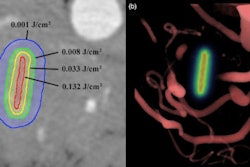Gout is on the rise in the U.S., and while it can be hard to diagnose using traditional methods, dual-energy CT (DECT) makes the task much easier, according to a new study in Annals of the Rheumatic Diseases.
The traditional way to diagnose gout, an inflammatory form of arthritis, is by drawing fluid or tissue from an affected joint using fine-needle aspiration and looking for uric acid crystals. But it doesn't always work, said researchers from the Mayo Clinic in Rochester, MN.
In their new study, a team including Dr. Tim Bongartz and senior author Cynthia McCullough, PhD, found gout in one-third of patients whose aspirates tested negative for the disease. CT allowed rheumatologists to diagnose gout and treat the patients with the appropriate medication.
The study examined the utility of DECT in a broad spectrum of patients and found that imaging worked particularly well in those who had experienced several gout-like flares but had received several negative needle aspirates. When CT found what appeared to be uric acid crystals, ultrasound-guided aspirates were then taken and tested for the crystals.
Early and accurate gout diagnosis is critical because of the different medications and doses used to treat it, according to the study authors. Proper medication and dietary changes can help prevent further gout attacks and the spread of the disease to other joints.
"What we are learning from the dual-energy CT scans has really changed our perception of where gout can occur and how it can manifest," Bongartz said in a statement.



















